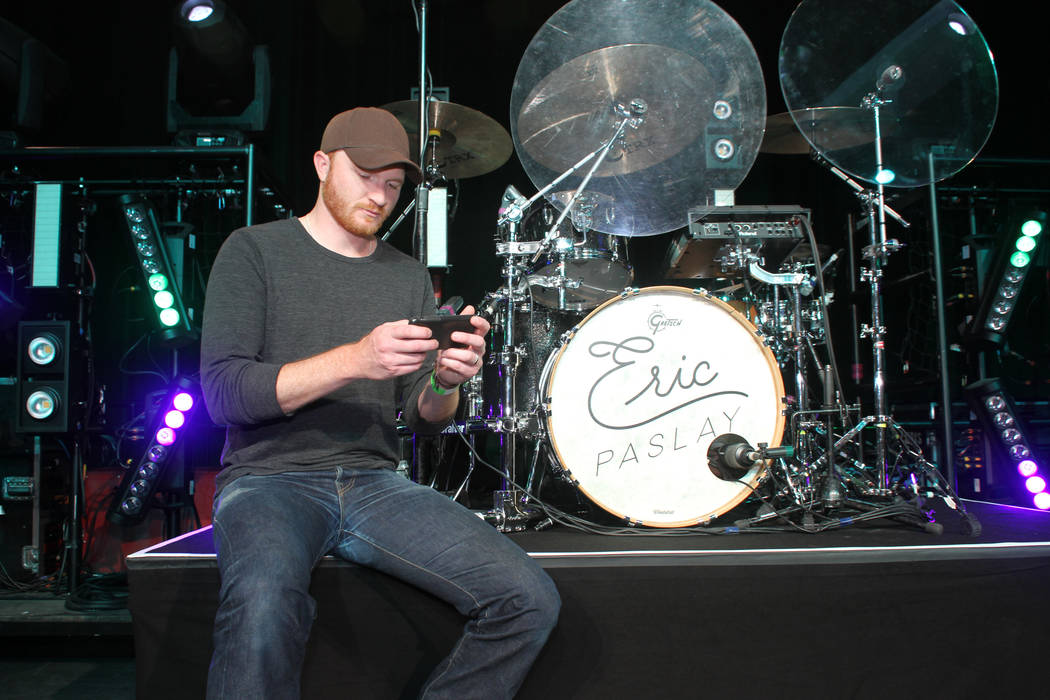Continuous glucose monitor keeps Eric Paslay in tune at ACM performance
When Eric Paslay performs, he’s surrounded by guitars and mics and amps and the usual onstage items that accompany any up-and-coming performer.
Down to, even, that cup of something on the drum riser that Paslay might swig from as the show goes on. And when he does, audiences often assume that it’s something alcoholic, befitting the stereotype of a country star.
So how disappointed would they be to discover it’s just orange juice, standing at the ready in case Paslay’s blood glucose level drops?
It’s all part of living with diabetes, an undertaking made even more rigorous for Paslay by a performer’s lifestyle that includes hard-rocking shows and continual travel, including this past Saturday’s ACM Party for a Cause at the Hard Rock Hotel.
Paslay, 34, was diagnosed with Type 1 diabetes when he was 10. The diagnosis wasn’t easy for Paslay, a rambunctious Texas kid, or his parents. But, he said, “I always had great doctors who said, basically, ‘You can do whatever you want.’ So I grew up and got to play sports and play in bands.”
I always had great doctors who said, basically, ‘You can do whatever you want.’ So I grew up and got to play sports and play in bands.
As his interest in music grew, Paslay found that the usual challenges of managing diabetes took on new dimensions — from having to prick guitar-playing fingers for blood samples for testing to managing blood glucose fluctuations during an energetic show.
The singer-songwriter recalls times when out-of-range glucose levels would make him feel drowsy or disconnected onstage or even make him forget song lyrics.
However, Paslay finds that using a continuous glucose monitor can make performing, and life, a bit easier to manage.
Through an adhesive sensor on his abdomen and a hair-thin probe positioned under his skin, Paslay’s blood glucose readings are taken every five minutes and sent to an app on his smartphone. There, instead of the discrete, single-point-in-time readings conventional monitors give, he can see which way his glucose levels are trending and take earlier interventions — like swigging that orange juice — when he needs it.
If Paslay gets too carried away during a performance, the device will send the readings to the smartphones of his tour manager and his wife, who can remind him to do what needs to be done. All of this frees him up to concentrate on the show.
Paslay has scored five No. 1 hits and has earned both Grammy and ACM nominations. He suspects that some fans know he has diabetes, and he welcomes the chance to share his experiences with those who don’t.
That’s particularly true with kids. Paslay says children often will come up to him and show him their own monitors, or talk about their own struggles with the disease.
“They look up at me — and I’m five-foot-sixteen — and they meet me, and they’ve seen me dance around on the stage, and to them it looks like anything’s possible,” Paslay says.
His message to them: “You can do what you want. Don’t let diabetes hold you back.”
Contact John Przybys at jprzybys@reviewjournal.com or 702-383-0280. Follow @JJPrzybys on Twitter.
Type 1 diabetes
Type 1 diabetes — which once was referred to as juvenile diabetes — usually is diagnosed in children and young adults, according to the American Diabetes Association. Only 5 percent of people with diabetes have the Type 1 form of the disease.
In the body, sugars and starches from foods are broken down into glucose, which is used for energy.
In Type 1 diabetes, the body does not produce insulin, which it uses to move glucose from the bloodstream into the body's cells. Insulin therapy and other treatments are used to manage Type 1 diabetes, which even kids can learn to do.
For more information about diabetes, visit the American Diabetes Association (www.diabetes.org).



















